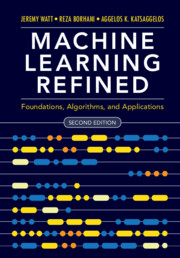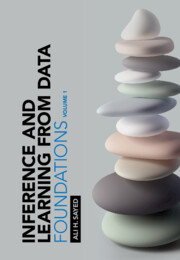Machine Learning Refined
With its intuitive yet rigorous approach to machine learning, this text provides students with the fundamental knowledge and practical tools needed to conduct research and build data-driven products. The authors prioritize geometric intuition and algorithmic thinking, and include detail on all the essential mathematical prerequisites, to offer a fresh and accessible way to learn. Practical applications are emphasized, with examples from disciplines including computer vision, natural language processing, economics, neuroscience, recommender systems, physics, and biology. Over 300 color illustrations are included and have been meticulously designed to enable an intuitive grasp of technical concepts, and over 100 in-depth coding exercises (in Python) provide a real understanding of crucial machine learning algorithms. A suite of online resources including sample code, data sets, interactive lecture slides, and a solutions manual are provided online, making this an ideal text both for graduate courses on machine learning and for individual reference and self-study.
- Encourages geometric intuition and algorithmic thinking to provide an intuitive understanding of key concepts and an interactive way of learning
- Features coding exercises for Python to help put knowledge into practice
- Emphasizes practical applications, with real-world examples, to give students the confidence to conduct research, build products, and solve problems
- Completely self-contained, with appendices covering the essential mathematical prerequisites
Reviews & endorsements
'An excellent book that treats the fundamentals of machine learning from basic principles to practical implementation. The book is suitable as a text for senior-level and first-year graduate courses in engineering and computer science. It is well organized and covers basic concepts and algorithms in mathematical optimization methods, linear learning, and nonlinear learning techniques. The book is nicely illustrated in multiple colors and contains numerous examples and coding exercises using Python.' John G. Proakis, University of California, San Diego
'Some machine learning books cover only programming aspects, often relying on outdated software tools; some focus exclusively on neural networks; others, solely on theoretical foundations; and yet more books detail advanced topics for the specialist. This fully revised and expanded text provides a broad and accessible introduction to machine learning for engineering and computer science students. The presentation builds on first principles and geometric intuition, while offering real-world examples, commented implementations in Python, and computational exercises. I expect this book to become a key resource for students and researchers.' Osvaldo Simeone, Kings College London
'This book is great for getting started in machine learning. It builds up the tools of the trade from first principles, provides lots of examples, and explains one thing at a time at a steady pace. The level of detail and runnable code show what's really going when we run a learning algorithm.' David Duvenaud, University of Toronto
'This book covers various essential machine learning methods (e.g., regression, classification, clustering, dimensionality reduction, and deep learning) from a unified mathematical perspective of seeking the optimal model parameters that minimize a cost function. Every method is explained in a comprehensive, intuitive way, and mathematical understanding is aided and enhanced with many geometric illustrations and elegant Python implementations.' Kimiaki Sihrahama, Kindai University, Japan
'Books featuring machine learning are many, but those which are simple, intuitive, and yet theoretical are extraordinary 'outliers'. This book is a fantastic and easy way to launch yourself into the exciting world of machine learning, grasp its core concepts, and code them up in Python or Matlab. It was my inspiring guide in preparing my 'Machine Learning Blinks' on my BASIRA YouTube channel for both undergraduate and graduate levels.' Islem Rekik, Director of the Brain And SIgnal Research and Analysis (BASIRA) Laboratory
'With its intuitive yet rigorous approach to machine learning, this text provides students with the fundamental knowledge and practical tools needed to conduct research and build data-driven products. The authors prioritize geometric intuition and algorithmic thinking, and include detail on all the essential mathematical prerequisites, to offer a fresh and accessible way to learn. Practical applications are emphasized, with examples from disciplines including computer vision, natural language processing, economics, neuroscience, recommender systems, physics, and biology. Over 300 color illustrations are included and have been meticulously designed to enable an intuitive grasp of technical concepts, and over 100 in-depth coding exercises (in Python) provide a real understanding of crucial machine learning algorithms. A suite of online resources including sample code, data sets, interactive lecture slides, and a solutions manual are provided online, making this an ideal text both for graduate courses on machine learning and for individual reference and self-study.' politcommerce.com
'This is a comprehensive textbook on the fundamental concepts of machine learning. In the second edition, the authors provide a very accessible introduction to the main ideas behind machine learning models.' Helena Mihaljević, zbMATH
Product details
January 2020Hardback
9781108480727
594 pages
255 × 183 × 29 mm
1.36kg
316 colour illus. 127 exercises
Available
Table of Contents
- 1. Introduction to machine learning
- Part I. Mathematical Optimization:
- 2. Zero order optimization techniques
- 3. First order methods
- 4. Second order optimization techniques
- Part II. Linear Learning:
- 5. Linear regression
- 6. Linear two-class classification
- 7. Linear multi-class classification
- 8. Linear unsupervised learning
- 9. Feature engineering and selection
- Part III. Nonlinear Learning:
- 10. Principles of nonlinear feature engineering
- 11. Principles of feature learning
- 12. Kernel methods
- 13. Fully-connected neural networks
- 14. Tree-based learners
- Part IV. Appendices: Appendix A. Advanced first and second order optimization methods
- Appendix B. Derivatives and automatic differentiation
- Appendix C. Linear algebra.





